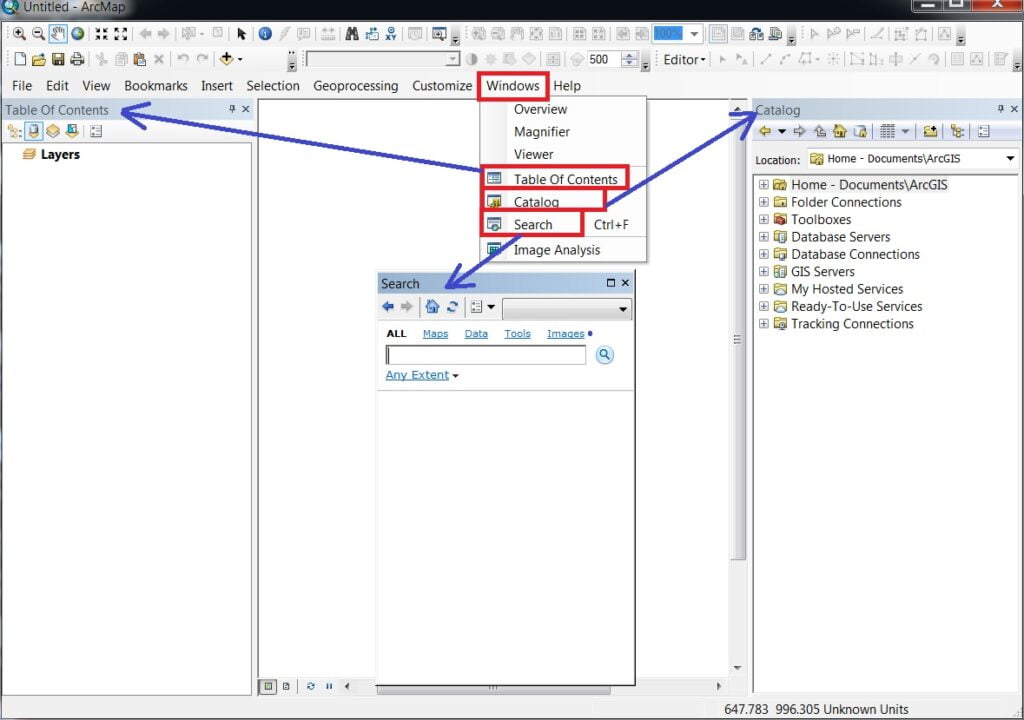Learn ArcGIS Software
This Tutorial we will discuss what is ArcGIS Software, and to How use?
First, Download ArcGIS Software, and Install this in your system.
The installation process is complete, with 4 different features available in your system.
ArcCatalog- use for managing the spatial data holdings and database designs, and for recording and viewing metadata.
Introduce ArcGIS Software Toolbars
The Standard Tools is the main toolbar in ArcGIS. This toolbar is managed to be full of work in ArcMap.

The Tools toolbar is one of the primary ways that you interact with geographic information displayed in the data frame.

| Button | Name |
|---|---|
Zoom In | |
Zoom Out | |
Pan | |
Full Extent | |
Fixed Zoom In | |
Fixed Zoom Out | |
Back | |
Forward | |
Select Features | |
Clear Selection | |
Select Elements | |
Identify | |
Hyperlink | |
HTML Pop-up | |
Measure | |
Find | |
Find Route | |
Go To XY Location | |
Open Time Slider Window | |
Create Viewer Window |
Learn ArcGIS Software Mapping & Database
ArcCatalog
ArcCatalog application provides a catalog window that is used to organize and manage Databases for ArcGIS Desktop. The organized and managed in ArcCatalog include:
- Folder Connections
- Geodatabases
- Raster files
- Toolboxes
- Geoprocessing tools, models, and Python scripts
- GIS services published using ArcGIS Server
- Database Servers and Connections, And much more.
ArcMap
Now install ArcGIS 10.3 Version, and open ArcMap.
Open ArcMap, and show the Main Manu bar.

Three primary features are necessary to perform any kind of task in ArcMap.
- Table of contents
- Catalog
- Search
In the Windows menu, 3 option is available.

Table of Contents
The table of contents lists all the layers on the map and shows what the features in each layer represent. Table of contents helps you manage the display order of map layers and symbol assignment, as well as to set the display and other properties of each map layer.
Catalog
The Catalog window provides a tree view of file folders and geodatabases. File folders are used to organize your ArcGIS documents and files. Catalog window is used to organize and manage various types of geographic information as logical collections—for example, the data, maps, and results of current GIS projects that you work with within ArcGIS.
Search
The Search box helps you to search and particular features within a second. ArcGIS includes the ability to search for GIS content and to put it work quickly—for example, by adding a search result to your map or by inserting a result item into a geographic operation.
In ArcMap, open any particular Toolbar to perform your task.
Dropdown Customize in Menubar, select Toolbars, and now choose your project needed Toolbars.

ArcMap display map contents in one of 2 views:
Menu bar dropdown View and select Data view or Layout view.

In the ArcMap data view, the map is the data frame. Within a data frame, you work with GIS information presented through map layers using geographic coordinates.
The Layout view is used to design and author a map for printing, exporting, or publishing. The data view hides all the map elements on the layout, such as titles, north arrows, and scale bars, and lets you focus on the data in a single data frame.
Map Layers
A Map Layer represents geographic data in ArcMap, such as a particular theme of data.
Page Layout
A Page Layout is a collection of map elements organized on a virtual page, designed for map printing.
Saving and Opening a Map Document
When you save a map you have created in ArcMap, it will be saved as a file on the disk. A filename extension (.mxd). In later sessions, you can work with an existing .mxd file by double-clicking the document to open it.
ArcScene
ArcScene is a 3D viewer that is that allows to navigate and interact with 3D feature and Raster data. Based on OpenGL, ArcScene supports complex 3D line symbology and texture mapping as well as Surface creation and display of TIN. Vector features are rendered as vectors, and raster data is down sampled or configured into a fixed number of rows/columns you set.
ArcGlobe
ArcGlobe application is generally designed to be used with very large datasets and allows for seamless visualization of both raster and feature data. It is based on a global view, with all data projected into a global Cube projection and displayed at varying levels of detail, organized into tiles. Vector features are generally rasterized and displayed according to their associated LOD, which assists in very fast navigation and display.




